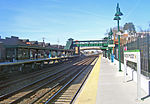Hastings-on-Hudson, New York
Greenburgh, New YorkNew York (state) populated places on the Hudson RiverVague or ambiguous time from February 2015Villages in Westchester County, New York

Hastings-on-Hudson is a village in Westchester County located in the southwestern part of the town of Greenburgh in the state of New York, United States. It is located on the eastern bank of the Hudson River, approximately 20 miles (32 km) north of midtown Manhattan in New York City, and is served by a stop on the Metro-North Hudson Line. To the north of Hastings-on-Hudson is the village of Dobbs Ferry, to the south, the city of Yonkers, and to the east unincorporated parts of Greenburgh. As of the 2020 US Census, it had a population of 8,590. The town lies on U.S. Route 9, "Broadway", along with the Saw Mill River Parkway and I-287.
Excerpt from the Wikipedia article Hastings-on-Hudson, New York (License: CC BY-SA 3.0, Authors, Images).Hastings-on-Hudson, New York
Farragut Avenue,
Geographical coordinates (GPS) Address Nearby Places Show on map
Geographical coordinates (GPS)
| Latitude | Longitude |
|---|---|
| N 40.991111111111 ° | E -73.874166666667 ° |
Address
Farragut Avenue 135
10706
New York, United States
Open on Google Maps







